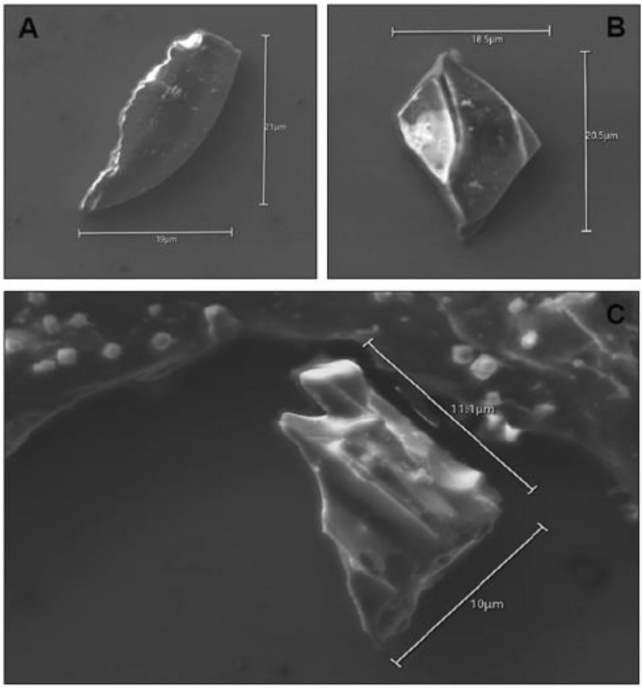Glass fragments from an ancient volcanic eruption found in Antarctic ice
- October 11, 2023
- 0
Nearly 2,000 years ago, when Rome was in its heyday, a volcano erupted on New Zealand’s North Island so powerful it was believed to have sent ash across
Nearly 2,000 years ago, when Rome was in its heyday, a volcano erupted on New Zealand’s North Island so powerful it was believed to have sent ash across

Nearly 2,000 years ago, when Rome was in its heyday, a volcano erupted on New Zealand’s North Island so powerful it was believed to have sent ash across the empire half a world away. Scientists have so far found six pieces of glass, attributed to the heat of the explosion, that were thrown 5,000 kilometers (3,100 miles) south and remained buried under 280 meters of Antarctic ice for about 2,000 years.
The seventh fragment, left over from an earlier eruption of the same volcano, helped the team determine the precise origin of the eruption and confirm the timing of the explosive event.
“Together, the seven fragments provide a unique and indisputable dual fingerprint of the Taupo volcano as a source,” says environmental scientist Stephen Piva, lead author of the study and a PhD at Te Herenga Waka-Victoria University of Wellington.
Taupo has been active for about 300,000 years, but the timing of the last major eruption (one of the largest and most energetic eruptions on Earth in the last 5,000 years) is surprisingly difficult to determine.
Historical records from ancient Rome and China describing events around 186 AD. For example, he suggests that a distant volcanic eruption blurred the sky half a world away: The Sun was “red as blood and devoid of light” and “the sky was on fire,” the two authors wrote.
No matter how vivid these explanations are, they do not fully correspond to geological data. Sulfur deposits in ice cores are a common signal of volcanic activity, and ice cores from Antarctica and Greenland have narrowed the time of Taupo’s eruption to around AD 230, plus or minus a few decades.
But sulfur is emitted from volcanoes all over the world, so it’s not as accurate as scientists would like. Radiocarbon dating of logs buried in hot volcanic flows from the Taupo eruption allowed the time to be refined to around AD 232 (1,790 years ago). The absence of preserved fruits and seeds, as well as darker outer latewood, on these trees suggests that the volcano erupted at its peak in late summer or autumn, although the year of the eruption is still disputed.
Thereupon, Piva and his colleagues examined a 764-meter-long ice core extracted from the Ross Ice Sheet in West Antarctica, filled with 83,000 years of climate information. Researchers found seven glass fragments between 10 and 20 microns long, made of the granite-like mineral rhyolite, at a depth of 279 meters.

Their geochemical composition matched other samples from the Taupō eruption collected in New Zealand. One piece in particular stood out: It matched volcanic glass from the Taupo Ōruanui volcano’s previous supereruption, which occurred 25,600 years ago.
While this Taupo “double print” gave researchers more confidence in the source of the glass shards, their location in the ice core was dated to the early months of the year around AD 230. Ōruanui glass, which is a century older but made from the same material, was probably mined from the Taupo volcano and thrown into the stratosphere along with newly formed glass fragments by the AD 230 eruption.
“A large eruption cloud will send a large volume of volcanic particles into the air and they will be dispersed over a wide area by the wind,” Piva explains.
While ice core dating still has some margin of error, the researchers say their findings provide an estimate of the age of the logs, which were likely destroyed instantly when engulfed by the hot eruption of Mount Taupo Volcano.
“Confirming the eruption date provides an opportunity to study the volcano’s potential global impact on the atmosphere and climate, which is critical to better understanding eruption history and behavior,” says Piva. Source
Source: Port Altele
As an experienced journalist and author, Mary has been reporting on the latest news and trends for over 5 years. With a passion for uncovering the stories behind the headlines, Mary has earned a reputation as a trusted voice in the world of journalism. Her writing style is insightful, engaging and thought-provoking, as she takes a deep dive into the most pressing issues of our time.